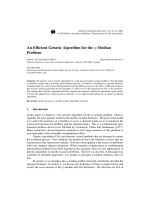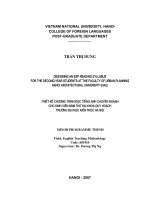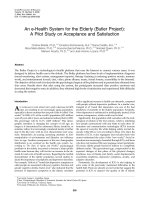Development of an automatic cleaning mechanism for the mesh filter of roof water harvesting
Bạn đang xem bản rút gọn của tài liệu. Xem và tải ngay bản đầy đủ của tài liệu tại đây (408.07 KB, 7 trang )
Int.J.Curr.Microbiol.App.Sci (2017) 6(4): 530-536
International Journal of Current Microbiology and Applied Sciences
ISSN: 2319-7706 Volume 6 Number 4 (2017) pp. 530-536
Journal homepage:
Original Research Article
/>
Development of an Automatic Cleaning Mechanism for the Mesh Filter of
Roof Water Harvesting
S.V. Lakshminarayana* and K.K. Sathian
Kelappaji College of Agricultural Engineering and Technology, Tavanur,
Thrissur - 679 573, Kerala, India
*Corresponding author
ABSTRACT
Keywords
Rainwater
harvesting, Mesh
filter, Total
suspended solids,
Automatic valve.
Article Info
Accepted:
06 March 2017
Available Online:
10 April 2017
One of the easiest and efficient way of water conservation to solve drinking water scarcity
is rooftop water harvesting. However, the technology has some limitations with regard to
its purification system. The commonly used sand and gravel filter is very prone to clogging
and its cleaning is not an easy job. At the same time, the alternative upward flow mesh
filter needs further improvement in cleaning efficiency and some hassle free drain cum
back washing mechanism. In upward flow mesh filter system, which creates anaerobic
condition will give foul smell. For avoiding anaerobic condition an automatic cleaning
mechanism for roof water harvesting has been developed. The automatic cleaning
mechanism was giving 92 % removal of the filtered out impurities from the filter system.
Further, the automatic flushing unit was draining the upward flow mesh filter unit
completely avoiding all possibilities of any anaerobic decomposition. It can be concluded
that the automatic flushing unit was a success in improving the performance of the upward
flow filter system.
Introduction
user friendly. One of the major limitations of
this filter system is its requirement of very
high periodic cleaning (preferably on a daily
basis), in order to avoid the foul smell
developed due to decomposition of organic
impurities in the stagnant water on the inlet
side of the micro mesh filter. Hence, an
automatic cleaning system for the micro mesh
filter system was an immediate necessity.
Also, testing of smaller size micro mesh
filters were required to evaluate their filtration
efficiency and discharge capacity.
The most commonly available filter system
for rainwater harvesting consists of sand and
gravel media placed in a container. They are
usually made of ferrocement casing and are
fitted to the top of the storage tank. In Kerala,
the most important impurity to be removed
from rooftop rain water is the organic
impurities such as mosses and other small
vegetation. The type of micro mesh filters
used in this system has proved to be an
alternative to sand and gravel media filter.
They also facilitate very ease of periodic
cleaning besides having good cleaning
efficiency. At the same time, micromesh
filters require further modifications and
improvisations to make it more efficient and
Therefore, in this context, this study has been
proposed to develop an automatic cleaning
mechanism for roof water harvesting and to
530
Int.J.Curr.Microbiol.App.Sci (2017) 6(4): 530-536
evaluate different sizes of micro mesh filters
with the given below specific objectives.
Development of automatic flushing system
Automatic flush system consists of a solenoid
valve of 50 mmɸ (1.5 inch ɸ) which is
connected to the bottom of the micro mesh
filter. The solenoid valve is made to open
once a day automatically for about 10 seconds
in order to flush out the impurities collected at
the bottom of the micro mesh filter. When the
solenoid valve opens, all the water collected
in the casing pipe and the conveyance pipe
fitted above the filter will be flowed down
with high velocity. In this gush of water, all
the impurities present in the filter unit will get
flushed out and the filter will be clean and
will be free of all the organic impurities.
Materials and Methods
Study area
Development of an automatic cleaning
mechanism for roof water harvesting system
and its evaluation have been conducted on the
various micro mesh filter in the campus of
Kelappaji
College
of
Agricultural
Engineering and Technology (KCAET),
Tavanur, Malappuram Dt, Kerala, India. The
Geographical reference of the study area is
10º 51' 20" N latitude and 75º 59' 5" E
longitude.
Automatic operation of the solenoid valve is
achieved through a light sensing- mechanism.
When the valve is opened once, it remains
open for 10 seconds so that there is enough
opportunity for the impurities to get flushed
out. Valve again will be opened after every
first light incidence on the sensor after a dark
period. The valve is connected to a 24 volts
electric supply the circuit diagram of the
valve unit is given in figure 2.
Development of upward flow micro mesh
filter system
The study includes the development of 60μ,
40μ, 25μ, 15μ, 12μ, 7μ, 5μ and 3μ mesh
filters. In all the cases, the micro meshes used
were made of stainless steel of grade 316. To
make the filter element, 50 mm PVC pipe of
30 cm length is taken and slots of 5 mm ɸ
were made on it at an approximate spacing of
15mm centre to centre in the case of all filters
except for 40 micron mesh filter.
Estimation of water quality parameters
A water quality analyzer, Systronics Water
Quality Analyser 371 was used to carry out
the physical analysis of the collected rooftop
rain water samples. It is a micro controller
based instrument for measuring pH, salinity,
electrical conductivity and TDS in water
sample one at a time. The analyser provides
both automatic and manual temperature
compensation. Calibration or standardization
of the instrument was done with standard
solutions. Provision for storing calibration of
all appropriate modes is provided with the
help of battery backup. This data can be
further used for measuring the unknown,
without recalibrating the instrument even after
switching it off. A 20 x 2 alphanumeric LCD
Number of holes in these filters varies from
196 to 230. Mesh area and slot area of
different filter elements are shown in table 1.
The filter elements were fitted in a casing
pipe of 90 mmɸ PVC. With the help of
threaded end cap, the unit is made easily
detachable to the filter assembly. Developed
Automatic cleaning mechanism for upward
flow micro mesh filter system is provided at
the bottom of the filter unit. The automatic
cleaning mechanism developed for upward
flow micro mesh filter system is shown in
figure 1.
531
Int.J.Curr.Microbiol.App.Sci (2017) 6(4): 530-536
display along with 14 keys enables the user to
select, set and operate the unit with ease. All
the results will be displayed electronically on
the display unit.
Total suspended solids in g/l =
……………..1
Where,
W1 = Initial weight of filter paper, g
W2 = Weight of filter paper and the dry
material retained on the filter, g
V = Volume of water sample, ml
The important physical parameters which
include pH, electrical conductivity, salinity
and TDS of the rainwater and roof water
samples collected for the study were tested
with water quality analyser.
Estimation of filter efficiency of suspended
solids
Total suspended solids by gravimetric
method
Filter efficiency refers to the amount of
removal of impurities by the filter system.
Hence, the filtration efficiency has been
worked out based on the removal of the
suspended impurities. For this, the
concentrations of suspended solids in the
water before filtering and after filtering were
found by the gravimetric method. Then,
efficiency of the filters has been determined
by the following equation.
Total suspended solids (TSS) are defined as
the portion of total solids in a water sample
retained by a glass fiber filter of pore size
greater than 2 μ. Total suspended solids are
particles that are larger than 2 microns, found
in the water column and anything smaller than
2 microns (average filter size) is considered as
dissolved solid.
Most of the suspended solids are made from
inorganic materials, though bacteria and algae
can also contribute to the total solids
concentration. These solids include anything
drifting or floating in the water, from
sediment, silt, and sand to plankton and algae.
Organic particles from decomposing materials
can also contribute to the TSS concentration.
E=
…………..2
Where,
E = Efficiency of the filter, %
Sb = Suspended solids before filtering, mg/l.
Sa= Suspended solids after filtering, mg/l.
For measuring suspended solids, the water is
filtered through a fine filter (Whattmann,
Grade 1, 110 mm ɸ) and the dried and cooled
material retained on the filter is weighed. The
drying was carried out for one hour in an oven
at 105º C. The filter paper was dried prior to
the filtration for 30 minutes in order to make
the water content of the filter paper equal to
that after drying with filtered out impurities.
Hence, the filter paper with impurities dried
in the oven is kept in the room temperature
for about 30 minutes for cooling and then
only its weight is determined
Discharge rate of different filter systems
Volumetric measurement
Discharge rate of the micro mesh filters are
very important as the filter system demands
high flow rate during different rainfall events,
especially during high rainfall intensities. If
the filter discharge rate is less, there will be
overflow of rooftop collected water from
gutters which give rise to loss of water in one
account and undesirable situation of falling
water from the higher levels to the ground.
Hence, discharge rates of every micro mesh
532
Int.J.Curr.Microbiol.App.Sci (2017) 6(4): 530-536
filter was evaluated. For the discharge
measurements, outflow from the filters were
collected for a known time and the volume of
collected water is measured to get the
discharge. The discharge of the various filters
has been determined by the following
equation.
automatic flush to remove the filtered out
impurities from the mesh filter unit was tested
thoroughly. The light based opening of the
solenoid valve was taking place once in a day.
Duration of the opening of the valve was for
10 seconds. It was found that opening of the
solenoid valve for 10 seconds duration was
sufficient to remove all the water stagnant in
the upward flow filter mechanism. The
removal efficiency of the rooftop impurities
in the stagnant water was evaluated by
quantifying the impurities load before and
after the flush out. About 100 l of rooftop
water was allowed to pass through the filter
unit.
D = …………..3
Where,
D = Discharge, (l/s)
V= Volume, (l)
T= Time, (s)
Results and Discussion
The impurity load in the stagnant water in the
filter system was measured by gravimetric
method before and after the automatic flush
out. It was found that, the impurity load was
37.98 g before the automatic flush out and
after flushing out the remaining impurities
load in the system was 3.20g. The result is
presented in figure 3. Percentage removed of
impurities was 92 %. Further, the automatic
flushing unit was draining the filter unit
completely avoiding all possibilities of any
anaerobic decomposition. It can be concluded
that the automatic flushing unit was a success
in improving the performance of the upward
flow filter system.
The performance evaluation of automatic
cleaning mechanism for roof water harvesting
system developed for the study is presented
here. Micromesh filters of various mesh sizes
were evaluated with regard to the purification
of roof water. Various water quality
parameters tested were pH, EC, SAL, TDS
and TSS. Performance evaluation of the
automatic flush was mainly done based on
TSS gravimetric method.
Performance evaluation of the automatic
flush
Operation and the performance of the
Table.1 Mesh area and slot area of different filter elements
Mesh size (μ)
60
40
25
15
12
7
5
3
Mesh area (𝐜𝐦2)
447.45
447.45
447.45
447.45
447.45
447.45
447.45
447.45
No. slots
229
124
196
230
230
230
230
230
533
Slot area (𝐜𝐦2)
44.96
24.35
38.48
45.16
45.16
45.16
45.16
45.16
Int.J.Curr.Microbiol.App.Sci (2017) 6(4): 530-536
Fig.1 Upward flow micro mesh filter with automatic flush
Fig.2 Circuit diagram of automatic flush
534
Int.J.Curr.Microbiol.App.Sci (2017) 6(4): 530-536
Fig.3 Impurities load in the filter system before and after automatic flush out
Fig.4 Filtration efficiency of different micro mesh filters
Fig.5 Discharge rate of different filters per unit mesh area
and it shows very high efficiencies in the case
of all the eight filters. As expected, when the
mesh size decreases, the efficiency increases
and the highest efficiency of 100 % is obtained
for 3 micron mesh filter.
Filtration efficiency of suspended solids
The main function of the mesh filters are the
removal of suspended matter. Along with the
removal of suspended impurities it also helps in
reducing the presence of other undesirable
material and improves the overall quality of
portability of roof water. Hence, the filtration
efficiency of the mesh filters was evaluated
from the point of removal of suspended
impurities. The result is presented in figure 4
Discharge rate of different filter systems
Discharge rate of the different filters are
important in the case of roof water harvesting.
As rain last for shorter intervals, the incoming
535
Int.J.Curr.Microbiol.App.Sci (2017) 6(4): 530-536
roof water to the filter system also will be for
short duration but with high discharge. Here,
volumetric measurement was adopted in
determining the filtration rate. This information
will be of great use to others in designing mesh
filters to suit to their requirement. The discharge
rates of different filters at a hydraulic head of
1.5m are presented in figure 5. Even 3 micron
filter has a discharge of 0.37 l/s under a head of
flow of 1.5m. Filtration rate per unit area of
mesh has also been worked out. This discharge
rate is sufficient to contain the roof water inflow
expected for high rainfall intensities.
pp. 118-124.
Kahinda, J.M., Taigbenu, A.E., and Boroto, J.B.
2007. Domestic rainwater harvesting to
improve water supply in rural South
Africa. J. Phys. Chem. Earth, 32: 10501057.
Kaposztasova, D., Vranayova, Z., Markovic,
and Purczb, P. 2014. Rainwater
harvesting, risk assessment and utilization
in Kosice- city, Slovakia. J. Procedia
Eng., 89: 1500 -1506.
Lee, Y., Bak, G., Han, M. 2012. Quality of
roof-harvested rainwater- comparison of
different roofing materials. Environ.
Pollut., 162: 422- 429.
Manoj, P.S. and Mathew, A.C. 2008.
Rejuvenation of water bodies by adopting
rainwater harvesting and groundwater
recharging practices in catchment area- a
case study. ICAR CPCRI, Pp.1-11.
Mendez. C.B., Brandon, K., and Brigit R.A.
2011. The effect of roofing material on
the quality of harvested rainwater. J.
Water Res., 45: 2049 -2059.
Rahmat, S., Zarina M., Sabariah, M. 2008.
Treatment of rainwater quality using sand
filter. Int. Conf. on Environ.
Rajan, S. 2001. Making water everybody’s
business practices and policy of water
harvesting, pp. 122-124.
Reena, K. and Sherring, A. 2012. Planning and
cost estimation of roof rainwater
harvesting structure. Int. J. Agric.
Environ. Biotechnol., 5(3): 225-232.
In conclusion the automatic flush system with
solenoid valve, light sensor and electronic
circuit developed for the automatic cleaning of
the upward flow mesh system was capable of
opening the valve for about 10 seconds once a
day. The performance of the filter unit in
removing the impurities retained after the rain
water filtration showed that automatic flush was
removing 92% of the retained impurities on the
inlet side of the micro mesh filter. Also it
empties the rainwater retained in the upward
flow filter system completely and eliminates the
possibility of any anaerobic decomposition.
Filtration rate of mesh filters were sufficient for
roof water harvesting, even 3 μ mesh gave a
filtration rate of 0.37 l/s at a hydraulic head of
1.5 m. It can be concluded that 3 micron mesh
filter with automatic flush can function as a fool
proof mechanism for filtering rooftop rain
water.
References
Helmreich, B. and Horn, H. 2008. Opportunities
in rainwater harvesting. IWQC, Germany.
How to cite this article:
Lakshminarayana, S.V. and Sathian, K.K. 2017. Development of an Automatic Cleaning
Mechanism for the Mesh Filter of Roof Water Harvesting. Int.J.Curr.Microbiol.App.Sci. 6(4): 530536. doi: />
536









